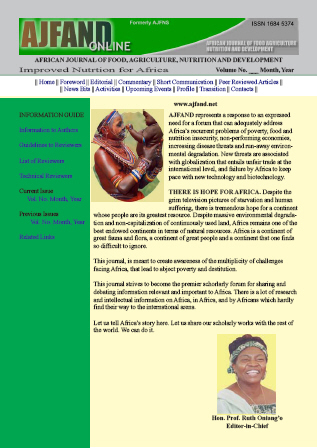
|
African Journal of Food, Agriculture, Nutrition and Development
Rural Outreach Program
ISSN: 1684-5358
EISSN: 1684-5358
Vol. 17, No. 4, 2017, pp. 12628-12640
|
 Bioline Code: nd17085
Bioline Code: nd17085
Full paper language: English
Document type: Study
Document available free of charge
|
|
|
African Journal of Food, Agriculture, Nutrition and Development, Vol. 17, No. 4, 2017, pp. 12628-12640
| en |
PREVALENCE OF IODINE DEFICIENCY AMONG SCHOOL CHILDREN AND ACCESS TO IODIZED SALT IN ZAMBIA
Katongo, C; Kabaghe, CG; Mubanga, F & Siamusantu, W
Abstract
This study, which covered all the ten provinces of Zambia, aimed at assessing the Iodine
Deficiency prevalence, and access to adequately iodised salt in the country. It was carried
out in 2011 and entailed determining the urinary iodine concentration (UIC) among 1,
283 school children from 30 selected schools and the amount of iodine in 875 salt
samples collected from the households of the children. The iodine concentration was
also determined in salt samples collected from 365 salt traders near the selected schools.
Each of the salt traders was requested to complete a questionnaire. In addition, a
questionnaire was administered to 75 teachers from the selected schools. The Urinary
Iodine Concentration (UIC) was assayed by the Sandell-Kolthoff reaction, after digesting
the urine with Ammonium Persulfate at 100oC. The iodine concentration in the salt was
determined using the quantitative titrimetric method. The data for the UIC and salt iodine
plus data from questionnaires were analysed using Excel and Statistical Package for
Social Sciences version 15 (SPSS 15). The median urinary iodine concentration (MUIC)
was 248.5μg/l and the Interquartile Range (IQR) was 145 – 380 μg/L. These results
indicated that Iodine Deficiency was not of public health concern among children in
Zambia at the time of this study. However, the proportion of households with access to
adequately iodised salt (15-40 ppm iodine) was 53%, which is below the recommended
target of 90% or more household coverage. Results from questionnaires indicated that
the challenges faced by the Zambian Government in attaining Universal Salt Iodisation
(USI) include: (i) lack of sustainability of local salt iodisation in local salt producing
areas, (ii) weak enforcement of the law on salt iodisation, (iii) poor packaging and storage
of salt by traders and households, (iv) limited knowledge of the link between lack of
iodine in salt and iodine deficiency, and (v) relatively high cost of imported iodised salt
in local salt producing areas.
Keywords
Iodized; Salt; Iodine Deficiency; Universal Salt Iodisation; Zambia
|
| |
© Copyright 2016 - African Journal of Food, Agriculture, Nutrition and Development
Alternative site location: http://www.ajfand.net/
|
|
